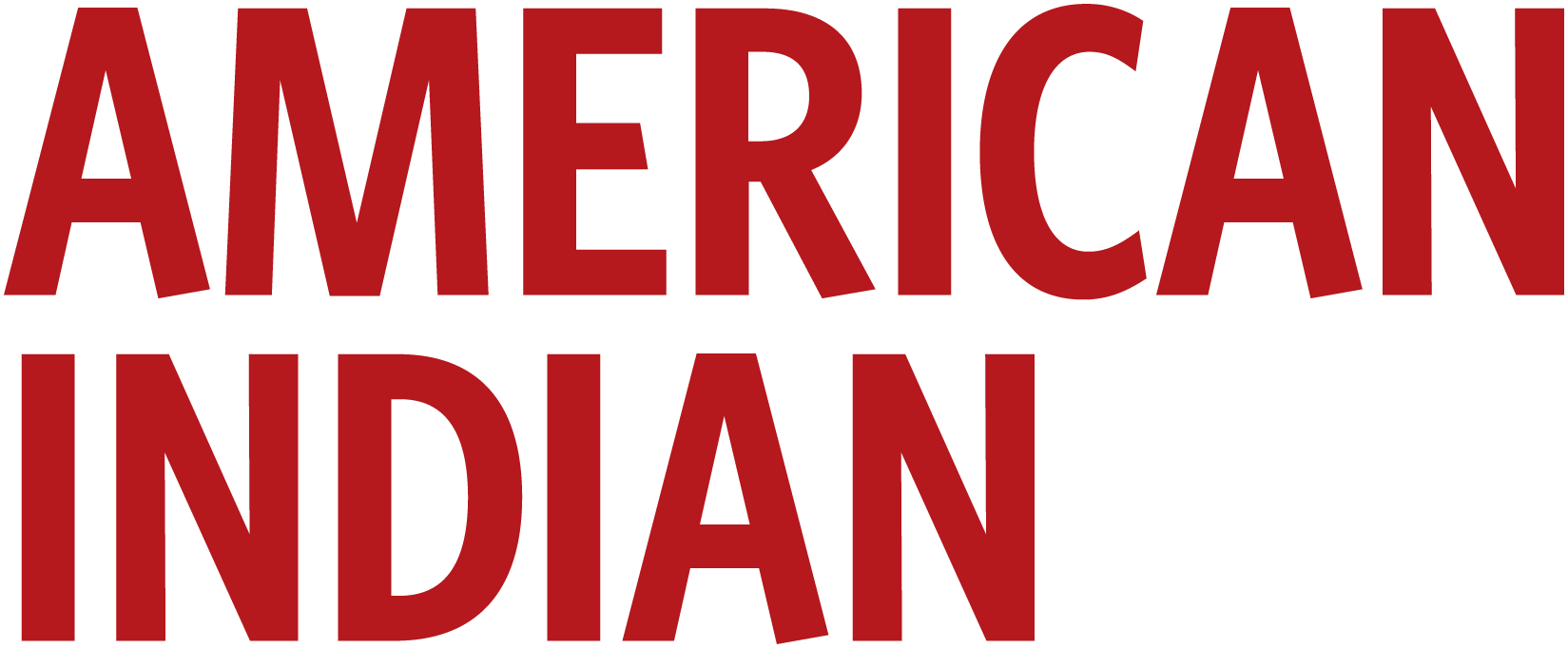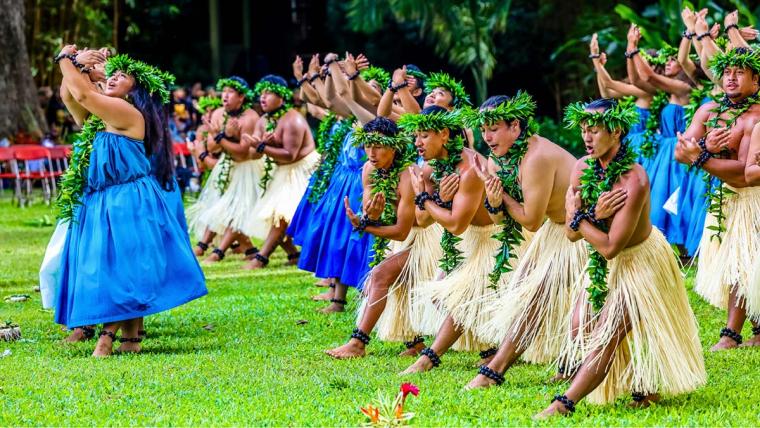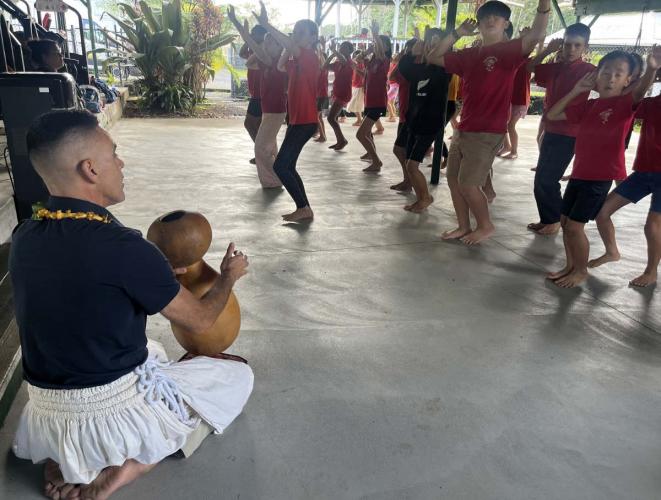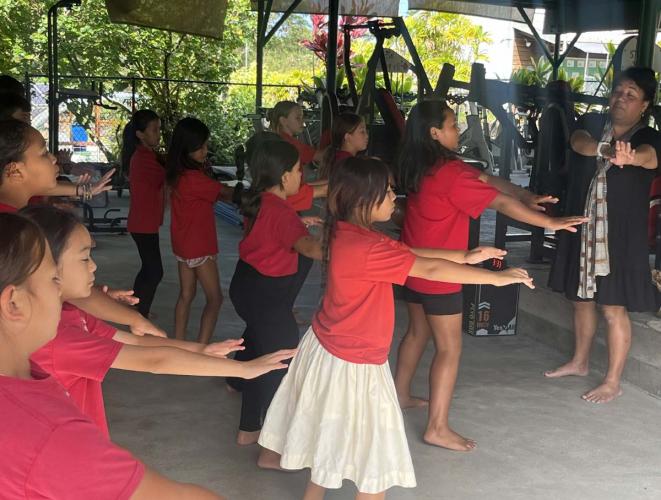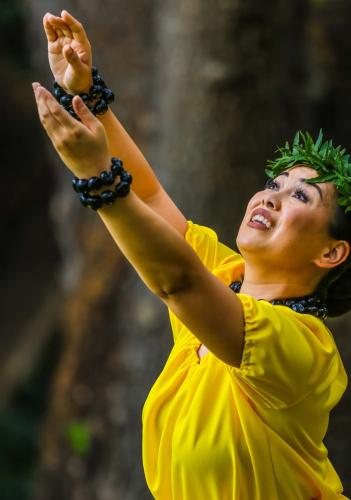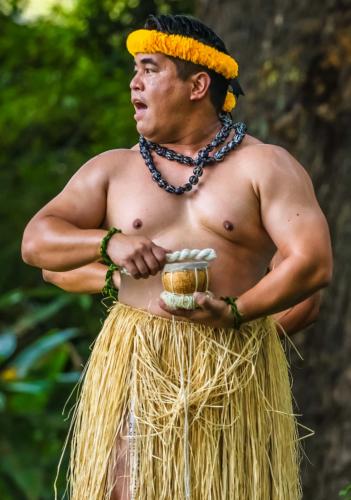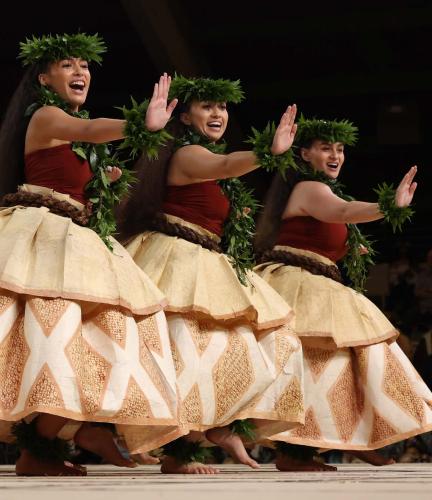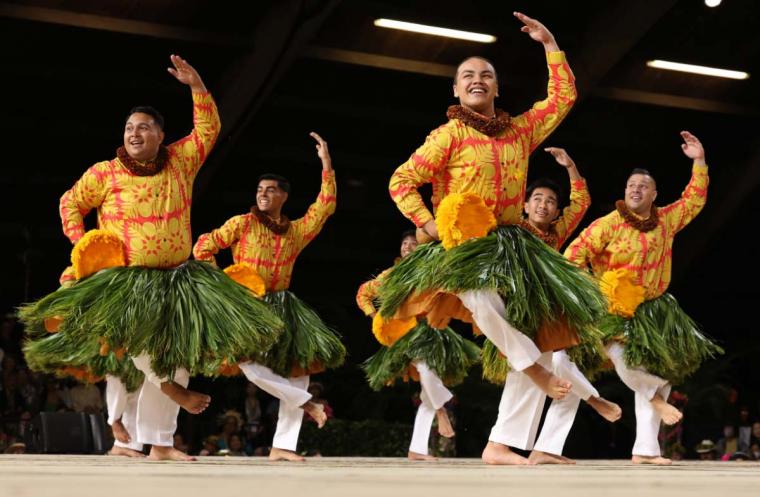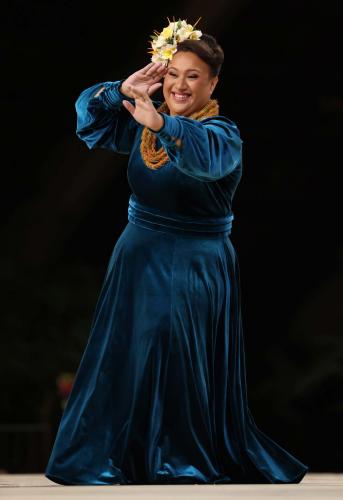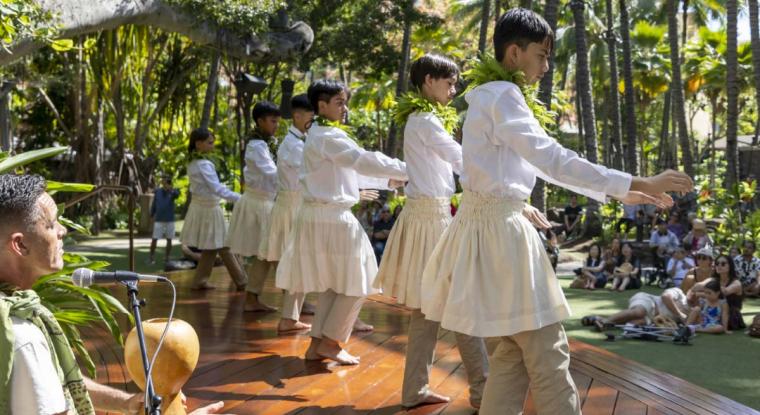In Puna, Hawai‘i, rows of young hula dancers in bright red school uniforms fill the open-air pavilion for hula practice. Some move with a natural fluidity, others with a determined focus and still others with a joyful abandon. Their bare feet are unbothered by the rough concrete floor.
They ground themselves with softly bent knees as they extend their left foot forward, then their right foot. Their weight shifts in unison. Their lower bodies maintain the steady rhythm of the “ipu” (gourd) being struck by one of their instructors, Kekoa Harman, while their outstretched arms “paint the air” with the “‘ula nōweo” (bright red glow of the sun). A sense of reverence permeates their movements.
At the front of the class, his wife, Pelehonuamea Harman, guides them: “Hema (Left)!,” “‘Ākau” (Right)!,” she calls out. She inspects hand gestures, gently corrects when needed. “Ma‘ema‘e nā lima!,” she emphasizes. “Keep your hand gestures clean!”
In Hawai‘i, this sacred dance has been passed down from instructors such as the Harmans known as “kumu hula.” Its graceful movements paired with chants and songs had been a way to tell stories for centuries before missionaries dubbed this dance as pagan during the early 1800s. These youth practicing at Ke Kula ‘O Nāwahīokalani‘ōpu‘u, a “medium” Hawaiian language immersion school, at which all lessons and activities are taught in the medium of “‘Ōlelo” Hawai‘i,” or the Native Hawaiian language. They are the first hula practitioners taught exclusively in ‘Ōlelo Hawai‘i in nearly a century.
The Harmans founded this “hālau hula” (traditional hula school) to “renormalize” ‘Ōlelo Hawai‘i while perpetuating this traditional dance. More than 100 students, from preschoolers through adults, are enrolled in the hālau, most of them fluent speakers of Native Hawaiian language.
The resurgence of ‘Ōlelo Hawai‘i in recent decades has profoundly impacted the practice of hula, enriching the understanding of the dance’s historical, cultural and spiritual significance. As more hula dancers have embraced their Native language, they have been revitalizing both practices.
Storytelling Through Movement
Polynesians sailed to and settled the Hawaiian Islands more than a thousand years ago. Their descendants, Native Hawaiians, developed hula, which expresses their history, culture, spirituality and appreciation for nature. This traditional dance uses movements to portray the words of their “oli” (chant) or “mele” (song). Oli are compositions that are primarily chanted, whereas mele are may be sung or chanted with musical accompaniment.
Traditional hula outfits vary depending on the style and occasion. Both men and women wore “pa‘ū” (skirts) that were typically made of “kapa” (barkcloth) and nothing above their waists. These skirts would often be dyed and decorated with stamped and painted patterns. Hula practitioners of both sexes also adorn themselves with “lei” and “kūpe‘e.” Lei encircle the neck and head and are typically made of flowers, ferns and other foliage, while kūpe‘e decorate wrists and ankles, which are often made with shells but can also be made with ferns or other foliage and serve to draw attention to the movements of hands and feet.
For centuries, the hālau hula has been one of several spaces in Hawaiian society where traditional knowledge was transferred from one generation to the next. “Our stories got passed down through the songs that endured. So too did our ‘loina’—our customs and practices. You ask permission before you go and pick your greenery for hula. You ask permission before you enter the ‘hālau’ (school grounds). Some of these practices endured in hula schools,” said Pelehonuamea Harman.
Hula practitioners served as vital links, connecting Hawaiian society to the lessons of its past to ensure its future survival. Traditionally, hula was a sacred practice, demanding strict adherence to rules and customs meant to keep them spiritually pure and focused. Practitioners’ lives were devoted to this spiritual art form, and their actions were restricted, including what they could eat, where they could go and what they could wear. Their role gave them the exclusive responsibility of presenting offerings and prayers to the hula gods on behalf of the people. Hula was often performed at religious ceremonies, chiefly celebrations and historical commemorations. Many hula compositions were believed to be divinely inspired. In this sense, hula served as a conduit between the spiritual world and the human world.
Multiple Hawaiian “mo‘olelo” (stories) recount hula’s divine origins. The most frequently mentioned deity in hula prayers and protocol is the hula goddess Laka. She is portrayed in Hawaiian chants as the source of inspiration for the movements, chants and overall artistic expression of hula. In a separate story, Laka’s relative, the goddess Kapo, is credited as the first kumu hula. In Hawaiian mythology, Kapo set up residence in Kā‘ana, Moloka‘i, where she established the first hālau hula.
The mo‘olelo of the volcano goddess, Pele, and her sister, Hi‘iaka, is perhaps the most well-documented, with several versions appearing in Hawaiian language newspapers at the turn of the 20th century. In one version published from 1905 to 1906 in the newspaper Ka Na‘i Aupuni, the author Ho‘oulumāhiehie identifies Hi‘iakas as the patron goddess of hula. As the story goes, Hi‘iaka learned the dance from her companion Hōpoe, whom she observed dancing by the sea at Nānāhuki, Puna. Pele, driven by jealously, turned Hōpoe to stone. This epic hula saga is filled with chants and songs that continue to be preserved by practitioners today.
Hula had been thriving in Hawai‘i for centuries before the arrival of Westerners. British explorer Captain George Vancouver described a hula exhibition with an estimated 600 hula practitioners dancing and chanting in perfect unison. By the 1820s, Protestant missionaries from America arrived in Hawai‘i and condemned hula as a pagan practice.
Driven by concerns of “public morality” and the perceived “lewdness” of hula, authorities sought to regulate its practice. In 1830, Queen Ka‘ahumanu, a recent convert to Christianity, banned public hula performances. In 1851, a law required a license for public hula, with a hefty fine or imprisonment for unlicensed performances. Hula continued to be practiced, however, often in secret.
“Although so much of our traditions and knowledge was lost, a good amount of hula knowledge endured amongst our people. And although there were periods in our history where hula had to ‘go underground,’ once it was again acceptable or popular to dance hula, hula became synonymous with Hawai‘i and Hawaiian culture,” said Pelehonuamea Harman.
In 1874, King David Kalākaua revived hula in the public sphere. During his reign, he encouraged hālau hula and invited dancers to perform at the ‘Iolani Palace. But the revival was short lived with the overthrow of the Hawaiian Kingdom in 1893. Despite overwhelming opposition by the majority of Native Hawaiians, the U.S. government, at the urging of the self-proclaimed provisional government, annexed the Hawaiian Islands through a joint resolution of the U.S. Congress.
As a result of Hawai‘i’s incorporation into the United States, cultural suppression intensified and was coupled with land loss and a ban on ‘Ōlelo Hawai‘i in schools. Business elite and government officials began to view the islands’ natural and cultural resources as lucrative commodities. This led to the rise of tourism and the commodification of hula, with performances often tailored to meet the expectations of visitors.
While this provided some opportunities for hula dancers, it also risked diluting the cultural and spiritual significance of the practice. The poetry of the chant became subordinate to the dance form. Hula was choreographed for English language songs such as “Blue Hawai‘i” and “Lovely Hula Hands,” further disconnecting the practice from its Hawaiian language roots.
The 1970s saw a resurgence of Hawaiian language and culture known as the Hawaiian Renaissance. Hula became a symbol of Hawaiian identity and a means of reconnecting with ancestral traditions. Hālau hula became important centers for learning their Native language.
“The use of language in teaching hula is incredibly powerful because it allows us to connect with the dance on a spiritual level. When we approach the chant or song through the lens of our ancestors, we become vessels for their wisdom and experiences,” said Kekoa Harman. “The language carries the stories, emotions and history that have been passed down through generations, and it becomes a bridge between the past and the present.”
By the 1980s, however, the number of Native Hawaiian speakers had dropped dramatically. A 1983 survey indicated fewer than 2,000 Native speakers and less than 50 fluent speakers under the age of 18 inhabited the islands at that time. Hawaiian language advocates and educators established Hawaiian language immersion schools and rallied to overturn the ban on ‘Ōlelo Hawai‘i in public schools, which had been in place for 90 years.
The Hawaiian language revitalization movement took hold and continues to play a critical role in producing new generations of fluent speakers, many of whom are also kumu hula and hula practitioners. Hula’s resurgence amplified the importance of ‘Ōlelo Hawai‘i, which, in turn, strengthened hula’s practice.
“I love when I hear “‘ōlapa” (hula practitioners) talk about their favorite “mele” (song) or a certain hula that they learned that just becomes a standard for them. This tells me that they are thinking about the lyrics and connecting to them,” said Pelehonuamea Harman. “They learn to appreciate the nuances and beauty of our language through hula.”
Continuing an Ancestral Legacy
Harman comes from a long line of hula practitioners, going back at least six generations to a time when Hawaiian monarchs ruled the islands. “Within my family, certain dances were passed down from generation to generation,” said Pelehonuamea Harman. “My great-great-great grandmother, Nāli‘ipō‘aimoku, was a dancer in Queen Emma’s court. She taught her children and grandchildren. My great-grandmother, Mary Kawena Pukui, remembered learning dances and chants from her grandmother and mother.”
Pelehonuamea Harman’s great-grandmother was a well-known Hawaiian scholar, hula expert and educator. In honor of her lifelong dedication to the preservation of Hawaiian language and culture, Pukui is featured on the 2025 Native American $1 Coin. While Harman did not learn hula directly from Pukui, many of the hula dances taught in hālau were danced by Pukui.
Pelehonuamea Harman began formal hula training at age 2 under Kumu Hula Carolee Nishi and continued as a teenager under Kumu Hula Kaha‘i Topolinski. She and Kekoa met as high school students attending Kamehameha Schools during the 1990s and reconnected at the University of Hawai‘i at Hilo, where they both enrolled in the Hawaiian language classes. They then became Hawaiian language immersion teachers and raised their four children in ‘Ōlelo Hawai‘i.
In 2009, the then husband and wife team resumed formal hula training under Kumu Hula Kimo Alama Keaulana, who had preserved many of the hula dances passed down in Harman’s family. The couple completed their training in 2011 and entered the guild of kumu hula.
The Harmans opened Hālau I Ka Leo Ola O Nā Mamo (Hula School of the Living Language of the Descendants) in 2012. Harman said although their personal and professional lives had focused on restoring ‘Ōlelo Hawai‘i as a daily language in these islands, teaching hula was a natural extension of that effort.
Kekoa Harman said hula would not exist without the poetry, without the ‘ōlelo (language).“By immersing ourselves in the words, we not only learn the technical movements but also engage with the deeper meaning behind them. This connection creates a sacred space where both teachers and students can experience hula as more than just a physical dance.”
Christie and Jason Zimmer enrolled their children in the Harman’s hālau 10 years ago. “We are an ‘ohana [family] who is committed to learning ‘Ōlelo Hawai‘i. We joined Hālau I Ka Leo Ola O Nā Mamo because the mission of this hālau supports our family’s cultural values. Throughout the past decade, both our ‘keiki’ [children] have grown a deeper understanding of their self-identity as kanaka Hawai‘i from the mele, hula and mo‘olelo taught by both Kumu Pele and Kumu Kekoa.”
Kayla Asing signed-up her children for hālau to connect them to their culture. “It’s important to me that my keiki learn hula because it connects them to our ‘kūpuna’ [ancestors], our stories, our natural and spiritual environment and the traditions that shaped who we are,” said Asing. “It’s a way to carry our family legacy forward.”
This cultural connection through hula is paramount for Asing as she considers her children’s future. Like a growing number of parents in Hawai‘i, Asing is raising her children in the Hawaiian language. She said, “Raising them in our native language is the foundation of our identity, and how we ensure that ‘Ōlelo Hawai‘i isn’t just remembered but truly lived for generations to come.”
‘Ōlelo and Hula at the Smithsonian
Hālau I Ka Leo Ola O Nā Mamo has been invited to participate in the Smithsonian Folklife Festival in Washington, D.C., this summer to highlight the strength of the Native language revitalization movement, said Halena Kapuni-Reynolds, associate curator of Native Hawaiian history and culture at the Smithsonian’s National Museum of the American Indian. He is also a former Hawaiian language immersion student. “It’s really a privilege and a pleasure to be able to bring a group that represents my childhood experience, growing up in ‘kula kaiapuni’ [Hawaiian immersion]. In a lot of ways its a full-circle moment because I am not only able to be a supporter, but I can also be the interpreter and translator,” he said. “I think that speaks to the maturity of our Hawaiian language revitalization movement.”
According to the U.S. Census Bureau, Hawai‘i now has more than 18,000 Hawaiian language speakers and 29 Hawaiian language immersion schools. However, the long-term success of language revitalization efforts will depend on the ability to engage youth beyond schools, said Mary Linn, curator of culture and linguistic revitalization at the Smithsonian Center for Folklife and Cultural Heritage, which hosts the annual Folklife Festival. “Having things like hula that young people are doing outside of the classroom, that they love and enjoy, and it’s in the language, really helps to show that it’s a language of daily use and of living, of life and of love.”
When asked what success looks like for Hālau I Ka Leo Ola O Nā Mamo, Pelehonuamea Harman said it is spontaneous choreography. “They should be able to get up and dance at a party, a social setting, in a cultural event or ceremony and choose both the appropriate song and if appropriate, dance for that context. They should be able to listen to a song and ‘haku’ [compose] the dance on the spot.”
These young hula practitioners can now compose new chants and dances to document their history, culture and way of life, in the language of their ancestors. As more hula practitioners become fluent in Hawaiian and more Hawaiian speakers are trained in hula, this next generation will be in a unique position to expand the repertoire of hula, wielding their ancestral traditions as a powerful tool for self-determination.
“It’s important that when someone watches a hula, they can feel that connection—the dancer’s ability to honor and embody their ancestral knowledge and spirit,” said Pelehonuamea Harman. “In many ways, the true measure of a dancer’s skill is how well they can communicate that connection and bring the essence of the dance to life.”
